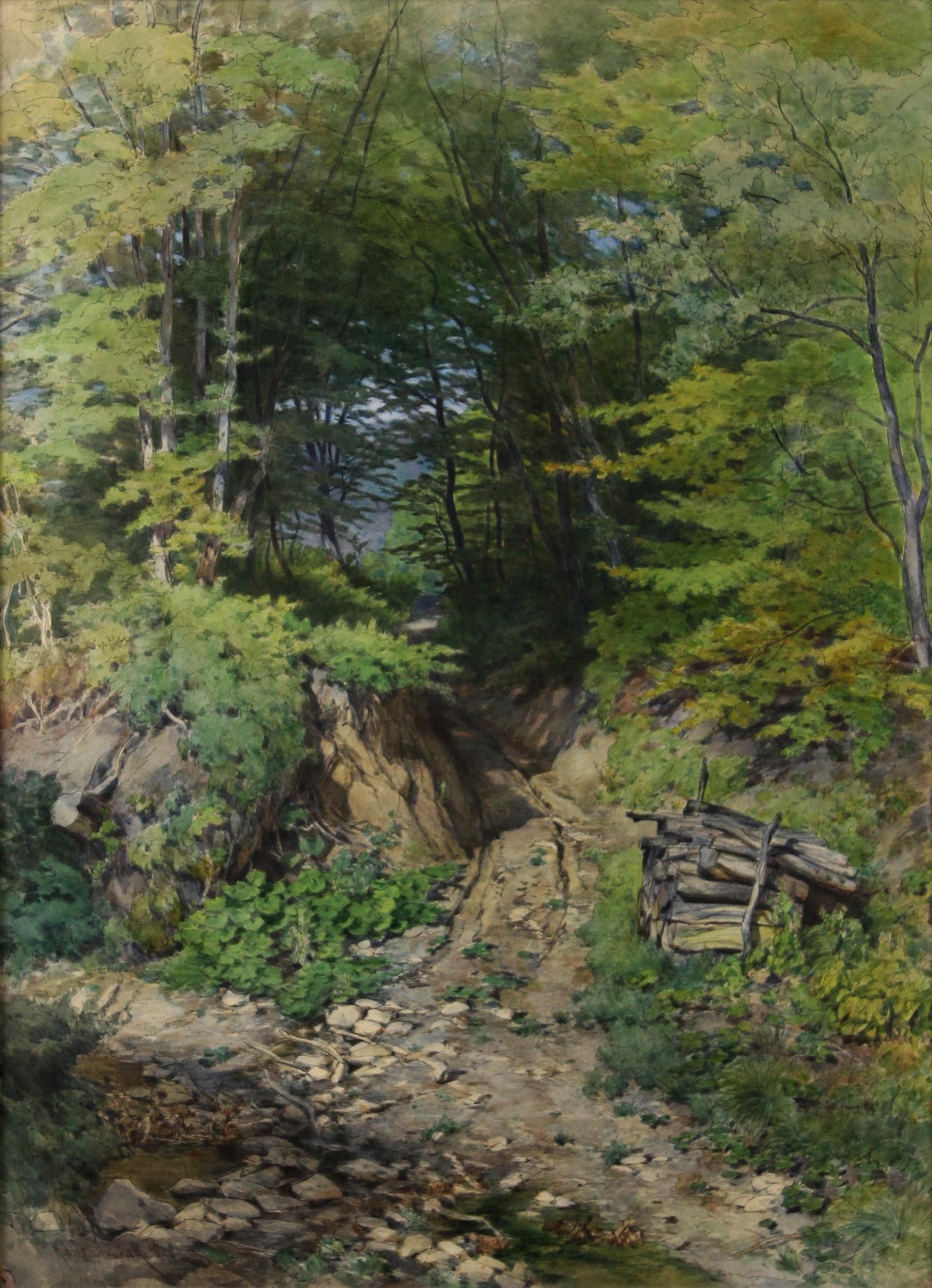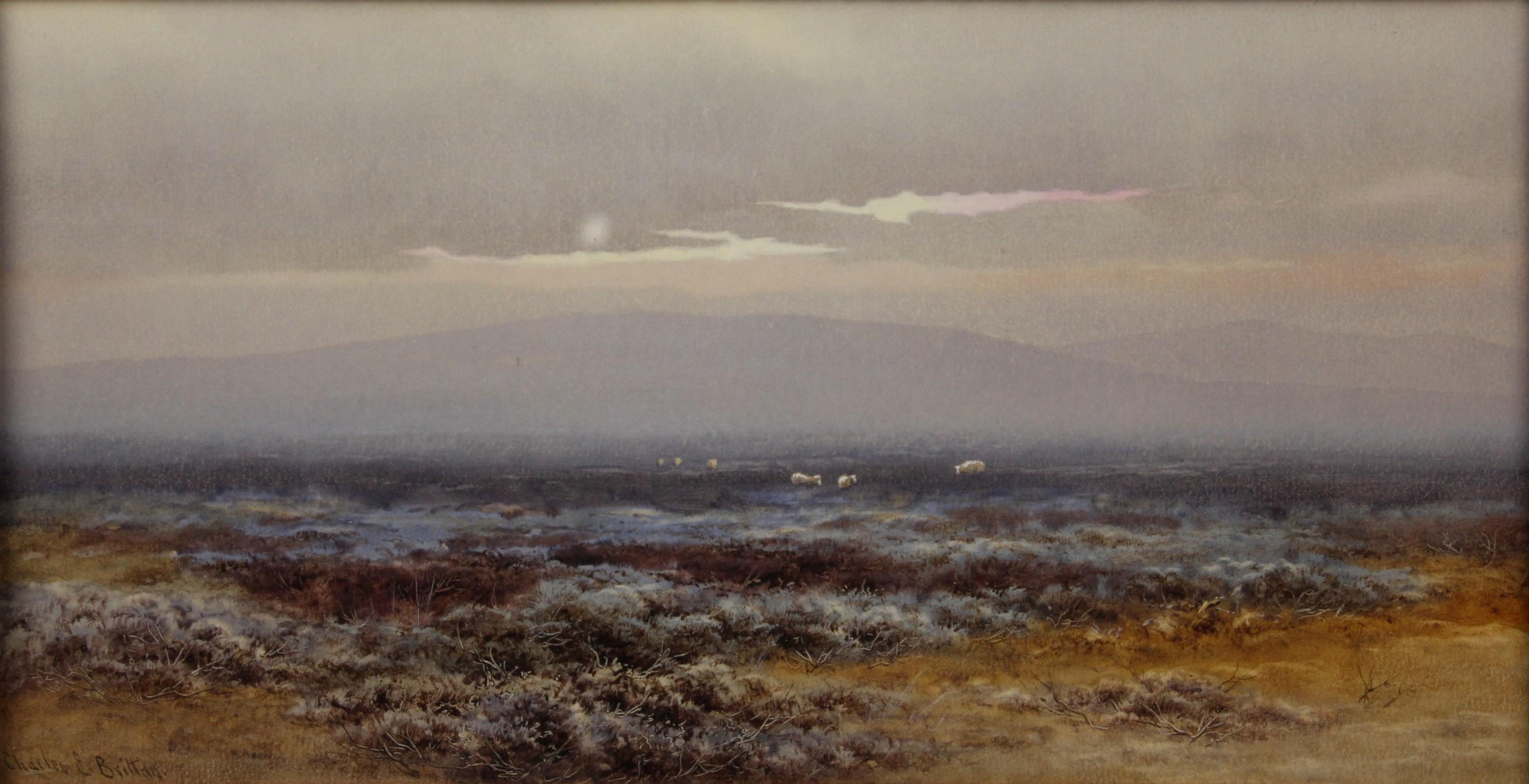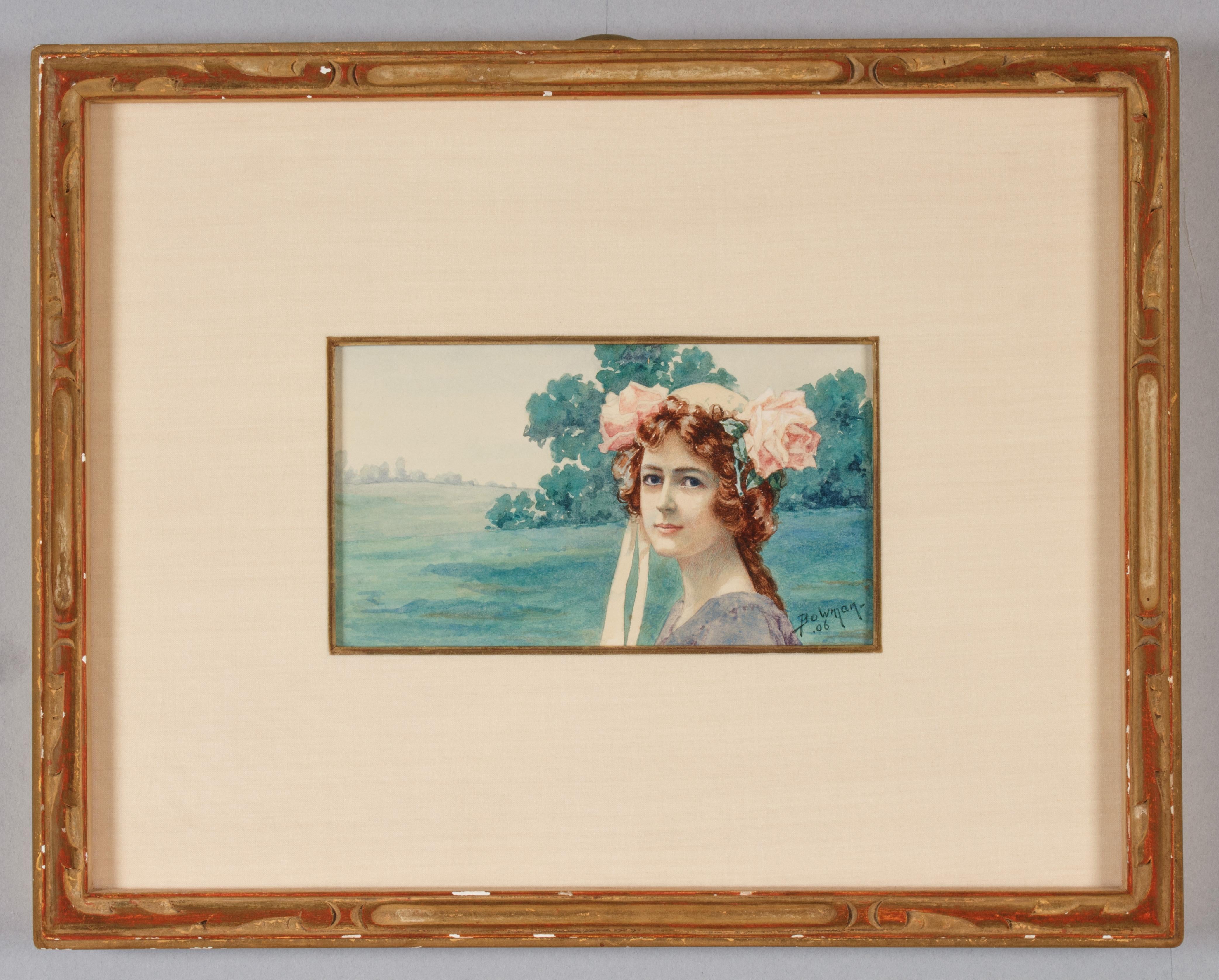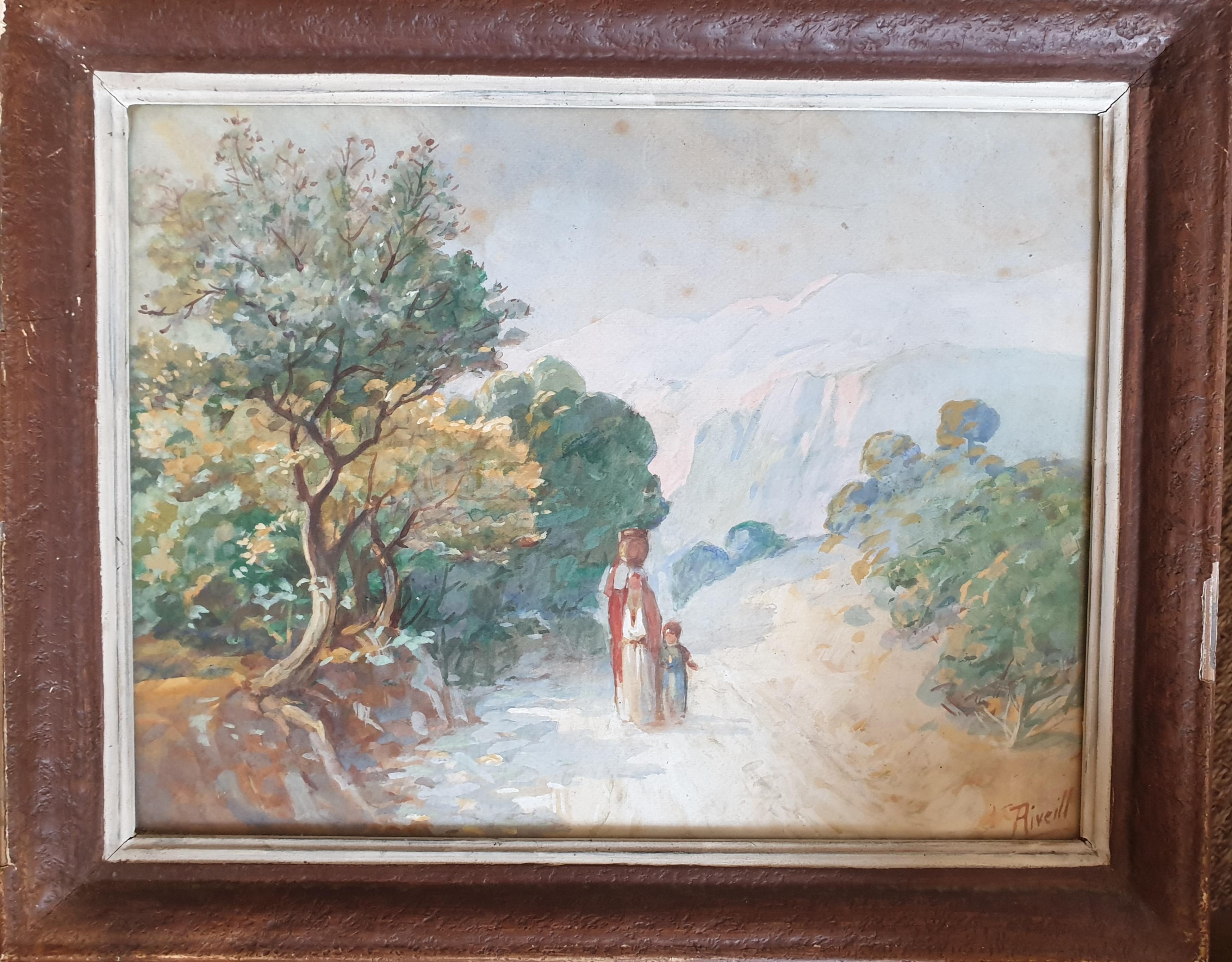Items Similar to Wettersteinkamm - The blue of the mountains -
Want more images or videos?
Request additional images or videos from the seller
1 of 8
Adalbert HolzerWettersteinkamm - The blue of the mountains -1923
1923
About the Item
Adalbert Holzer (1881 Munich - 1966 Munich). Wettersteinkamm. Watercolour, 29 x 34.5 cm (visible size), 37.5 x 43 cm (frame), signed and dated at lower right 'ADALBERT HOLZER [19]23'.
Framed behind glass. Frame shows signs of wear.
- The blue of the mountains -
About the artwork
The Wetterstein ridge is revealed to the viewer from a gentle, snow-covered hill. In contrast to conventional depictions of mountains, the painting is composed entirely of shades of blue, which condense into the blue-grey of the rock or fade into the white of the snow. As a complementary colour to the blue, Holzer virtuously activates the ochre ground. The uniform yet exciting polarity of the colours emphasises the massive majesty of the mountains and at the same time underlines the special character of the Wetterstein ridge. Holzer transferred the translucency of glass painting, in which he was originally trained, to watercolour and developed a pictorial language related to the art of Ferdinand Hodler, which earned him the nickname 'Master of Blue' and led to the appreciation of his watercolours in particular.
About the artist
After an apprenticeship as a stained glass painter at the Kunstgewerbeschule, Adalbert Holzer studied at the Munich Art Academy under Carl von Marr from 1904. Early on, however, Holzer was drawn to the mountains to paint. With his artist friend Otto Bauriedl, he repeatedly went into the mountains and mastered difficult ascents, such as the first ascent of the north face of the Spritzkar. From 1904, Holzer worked as a freelance artist, producing contributions inspired by Giovanni Segantini and Fritz Baer for the 'Jugend', the 'Jugendblätter' and the 'Leipziger Illustrierte'. Later he concentrated more and more on the mountain world and contributed pictures to the 'Deutsche Alpenzeitung', the 'Mitteilungen des Deutschen Alpenvereins' and the 'Bergkamarad'.
Holzer regularly took part in exhibitions at the Munich Glaspalast and, in 1912, at the Great Art Exhibition in Berlin.
"His ink, brush and pen drawings capture the mountain's personality with a few concise strokes, leaving room for artistic sensitivity. He achieves particular mastery in his watercolours and paintings in oil and tempera".
Josef Weingärtner
"A striking and outstanding strength of Holzer's is revealed in his ink drawings. Here every outline, every shadow is limited to the essential and characteristic, and no superfluous brushstroke detracts from the overall effect".
Fritz Schmitt
Selected Bibliography
Fritz Schmitt: Dem Bergmaler Adalbert Holzer zum Gedenken. In: Mitteilungen des Deutschen Alpenvereins 19,5 (September 1967), S. 123-124.
Erwin Georg Hipp: Adalbert Holzer. Maler der Berge und Bergsteiger, Leoni am Starnberger 2008.
GERMAN VERSION
Adalbert Holzer (1881 München - 1966 München). Wettersteinkamm. Aquarell, 29 x 34,5 cm (Sichtmaß), 37,5 x 43 cm (Rahmen), rechts unten signiert und datiert „ADALBERT HOLZER [19]23“.
Hinter Glas gerahmt. Rahmen mit Gebrauchsspuren.
- Das Blau der Berge -
zum Werk
Von einer sanften schneebedeckten Anhöhe aus offenbart sich dem Betrachter der Wettersteinkamm. Im Gegensatz zu konventionellen Gebirgsdarstellungen ist das Bild nur aus Blautönen aufgebaut, die sich zum Blaugrau des Felsgesteins verdichten oder zum Weiß des Schnees aufhellen. Als Komplementärfarbe zum Blau aktiviert Holzer auf virtuose Weise den ockerfarbenen Malgrund. Die einheitliche, aber dennoch in sich spannungsreiche Farbpolarität bringt die massive Majestät der Berge zum Aufleuchten und stellt dabei zugleich den besonderen Charakter des Wettersteinkamms heraus. Holzer hat das Durchscheinende der Glasmalerei, in der er ursprünglich ausgebildet worden war, ins Aquarell übertragen und eine der Kunst Ferdinand Hodlers verwandte Bildsprache entwickelt, die ihm den Beinamen ‚Meister des Blaus‘ eingetragen und zur Wertschätzung gerade seiner Aquarelle geführt hat.
zum Künstler
Nach einer Lehre als Glasmaler an der Kunstgewerbeschule studierte Adalbert Holzer ab 1904 an der Münchner Kunstakademie als Schüler Carl von Marrs. Schon früh zog es Holzer jedoch in die Berge, um dort zu malen. Mit seinem Künstlerfreund Otto Bauriedl ging er immer wieder ins Gebirge und bewältige schwierige Besteigungen, so den Erstdurchstieg der Spritzkar-Nordwand. Ab 1904 als freischaffender Künstler tätig, schuf Holzer an Giovanni Segantini und Fritz Baer inspirierte Beiträge für die ‚Jugend‘, die ‚Jugendblätter‘ und die ‚Leipziger Illustrierte‘. Später konzentrierte er sich zusehends auf die Bergwelt und lieferte unteren anderem für die ‚Deutsche Alpenzeitung‘, die ‚Mitteilungen des Deutschen Alpenvereins‘ und den ‚Bergkamarad‘ Bildbeiträge.
Holzer beteiligte sich regelmäßig an den Ausstellungen im Münchner Glaspalast und 1912 an der Große Kunst-Ausstellung in Berlin.
„Seine Tusch-, Pinsel- und Federzeichnungen erfassen mit einigen prägnanten Strichen den Berg in seiner jeweiligen Persönlichkeit und lassen dem künstlerischen Empfinden Raum. Besondere Meisterschaft erreicht er in den Aquarellen und in den mit Öl- und Temperafarben ausgeführten Gemälden.“
Josef Weingärtner
„Eine auffallende und überragende Stärke Holzers offenbart sich in seinen Tusche-Pinsel-Zeichnungen. Hier ist jeder Umriß, jeder Schattenauf das Wesentliche und Charakteristische beschränkt und kein überflüssiger Pinselstrich beeinträchtigt die Gesamtwirkung.“
Fritz Schmitt
Auswahlbibliographie
Fritz Schmitt: Dem Bergmaler Adalbert Holzer zum Gedenken. In: Mitteilungen des Deutschen Alpenvereins 19,5 (September 1967), S. 123-124.
Erwin Georg Hipp: Adalbert Holzer. Maler der Berge und Bergsteiger, Leoni am Starnberger 2008.
- Creator:Adalbert Holzer (1881 - 1966, German)
- Creation Year:1923
- Dimensions:Height: 11.42 in (29 cm)Width: 13.78 in (35 cm)Depth: 0.79 in (2 cm)
- Medium:
- Movement & Style:
- Period:
- Condition:
- Gallery Location:Berlin, DE
- Reference Number:1stDibs: LU2438212326362

About the Seller
5.0
Vetted Seller
These experienced sellers undergo a comprehensive evaluation by our team of in-house experts.
Established in 2014
1stDibs seller since 2023
7 sales on 1stDibs
Typical response time: 6 hours
- ShippingRetrieving quote...Ships From: Berlin, Germany
- Return PolicyA return for this item may be initiated within 14 days of delivery.
More From This SellerView All
- Shady hollow way - Into the heart of the forest -By Hans DvoràkLocated in Berlin, DEHans Dvořák (19th century). Shady hollow way in a sunny forest. Watercolour and pen-and-ink drawing, 58.5 x 43 cm (visible size), 70 x 55.5 cm (frame), signed and dated "Hans Dvořák ...Category
1880s Realist Landscape Drawings and Watercolors
MaterialsWatercolor
- High Moorland Landscape in the fog - The world as a transcendent phenomenon -Located in Berlin, DECharles Edward Brittan Jr (1870 Plymouth - 1949). High moor landscape in the fog. Gouache, signed at lower left "Charles E. Brittan", 18 x 34.5 cm (passepartout), 45 x 62 cm (frame)....Category
Early 20th Century Realist Landscape Drawings and Watercolors
MaterialsWatercolor
- Red blooming war landscape with dead soldier - Bleeding flowers -Located in Berlin, DEJohannes Friedrich Heinrich Hänsch (1875-1945), Red blooming war landscape with dead soldier, 1918. Watercolor and gouache on paper, 15 x 24.5 cm (image), 27 x 37 cm (sheet size / frame), monogrammed and dated "19JH18" at lower left. - Paper slightly darkened About the artwork Despite the relatively small format, the watercolor with an internal frame depicts a panoramic view of a flat landscape stretching to the horizon. As far as the eye can see, the poppies bloom in flaming red. The flowers are not rendered individually, however, creating an almost cohesive red surface. The bright red is interspersed with vegetal green. A complementary contrast that creates an intense color effect. In this color contrast, a white area breaks through from the middle ground, widening towards the foreground and surrounding a brown hole. Next to it, in blue, is the actual protagonist of the painting, the first thing that catches the eye: a dead soldier. Next to him is his helmet, revealing the empty interior. The brown, hollow shape corresponds to the hole in the ground. A shell funnel is surrounded by bright ash, which, like the inverted helmet, becomes a sign of death. The soldier's arms point to the funnel, while the empty helmet paraphrases the calotte of the skull and, like the funnel, thematizes the empty darkness of death. The soldier's body, however, is intact and not - as in Otto Dix's triptych "The War" - a dismembered corpse. Instead, Johannes Hänsch activates the landscape, especially the color, to illustrate a blooming landscape of death that extends from the shell funnel in the foreground to the rising column of smoke on the horizon. If the soldier's body is intact, the tangle of barbed wire emblematically placed over the empty helmet also appears tattered. On the right side of the picture, the barbed wire even seems to stretch its arms to the sky in horror. Against the background of this allegory, the content of the bright red also becomes clear: the landscape is drenched in blood, literally a sea of blood, and the single unknown soldier stands pars pro toto for all those who died on the battlefield. Dying in war is not dying in community, but in solitude. In order to emphasize the isolation in death, Johannes Hänsch has set the blue of the soldier in the axis given by his body in the middle ground of the picture into the red sea. A master of landscape painting, Hänsch succeeds in creating a natural-looking landscape allegory that illustrates the horror and death of war, without depicting the brutality of war itself. This singular 'war memorial' of the unknown soldier is the opposite of heroization and yet the dignity of the deceased soldier is preserved through the integrity of his body. About the artist As the son of the sculptor Adolf Haensch, the young Johannes received his first artistic training in his father's Berlin studio. However, he eventually decided to become a painter, and in 1897 he entered the Berlin Academy of Arts. He initially studied under Paul Vorgang and Eugen Bracht, and was particularly influenced by Bracht's increasingly colourful landscape painting. In 1901 he moved to the class of Friedrich Kallmorgen, with whom he spent several weeks on excursions into nature. In 1905 he became a master pupil of Albert Hertel, who taught him watercolour painting. From 1903 to 1933 he exhibited annually at the Great Berlin Art Exhibition, the exhibitions of the Berlin Artists' Association and the Munich Glaspalast. In 1905 he was awarded the Carl Blechen...Category
1910s Realist Figurative Drawings and Watercolors
MaterialsWatercolor
- Wind Dodgers at the Baltic SeaLocated in Berlin, DETheodor Scheerbaum (1897 Reichenbach im Vogtland), Wind Dodgers at the Baltic Sea. Watercolor on strong yellowish grained paper, 44 x 56 cm, signed by hand "Th[eodor] Scheerbaum" at ...Category
1950s Realist Landscape Drawings and Watercolors
MaterialsWatercolor
- Evening Cottage Scene / - Somewhere in Nowhere -Located in Berlin, DEArthur Claude Strachan (1865 Edinburgh - 1954 Minehead), Evening Cottage Scene. Watercolor on paper, mounted, 28 x 46 cm (visible size), 48 x 65 cm (fra...Category
Early 1900s Realist Landscape Drawings and Watercolors
MaterialsPaper
- The Ruins of St. Clement's Church in Visby, Sweden / - Real romanticism -Located in Berlin, DEOtto Günther-Naumburg (1856-1941), The Ruins of St. Clement's Church in Visby, Sweden. Watercolor and ink, heightened with white, on sand-colored paper, mounted on cardboard, 33 x 24...Category
Early 20th Century Realist Landscape Drawings and Watercolors
MaterialsPaper
You May Also Like
- Watercolor Portrait of a Girl with Roses signed Bowman 1906Located in Philadelphia, PAUnknown Artist (Bowman) (early twentieth century) Girl with Roses Watercolor on paper, 5 x 8 inches Framed: 13 x 16 inches Signed and dated at lower right: “Bowman/.06”Category
Early 1900s Realist Landscape Drawings and Watercolors
MaterialsPaper, Watercolor
- The Chestnut Vendor: an early 20th century Italian watercolor signed A.MattoliniLocated in Philadelphia, PAA. Mattolini (Italian, early twentieth century) The Chestnut Vendor Watercolor on paper, 12 3/4 X 9 inches Signed at lower left: “A Mattolini”Category
Early 20th Century Realist Figurative Drawings and Watercolors
MaterialsWatercolor, Paper
- The Watercarrier, Orientalist Watercolour.Located in Cotignac, FREarly 20th century orientalist watercolour on paper by Aiveill, signed bottom right. In art history, Orientalism is the imitation or depiction ...Category
Early 20th Century Realist Landscape Drawings and Watercolors
MaterialsPaper, Watercolor, Gouache
- Notre-Dame de Paris. Paper, watercolor, 26.5x18 cmBy Edward NevilLocated in Riga, LVEdward Nevil ( 1813 – 1901 ) Notre-Dame de Paris. Paper, watercolor, 26.5x18 cmCategory
Mid-19th Century Realist Landscape Drawings and Watercolors
MaterialsPaper, Watercolor
- Sunset Sailors is a Watercolor by Swedish Artist Carl L Lindqvist, Painted 1898Located in Stockholm, SEDiscover this watercolor "Sunset Sailors" by Carl L. Lindqvist (1856-1941). Step into the enchanting world of the Swedish artist Carl L. Lindqvist with his captivating watercolor pa...Category
1890s Realist Landscape Drawings and Watercolors
MaterialsWatercolor
- Quiet Contemplation: Rural Serenity in Hagborg's WatercolorBy August HagborgLocated in Stockholm, SEThe artwork we present is a rare watercolor by the distinguished Swedish artist August Hagborg, painted in the later part of his career between 1910 and 1920. This watercolour is a departure from Hagborg's often-seen beach scenes with mussel pickers and instead offers a glimpse into a serene, pastoral moment. The scene is set against a timber house, with a man and a woman standing alongside, their gazes directed away from the viewer, which invites contemplation about the story behind their distant stares. Watercolors by Hagborg are rare, making this piece particularly special. Its fine details suggest a mastery of the medium, likely honed over the years of his extensive career. A written letter from Göteborgs Konstmuseum, dated to the 1940s, suggests a later date for this piece. August Hagborg, born on May 26, 1852, in Gothenburg and passed away on April 30, 1921, in Paris, was a renowned figure in the art world. His education at the Royal Swedish Academy of Arts in Stockholm from 1871 to 1874 placed him among peers who would rise to prominence, such as Carl Larsson and Anders Zorn. Moving to Paris in the fall of 1875, Hagborg initially painted within the costume genre before finding his niche in coastal landscapes that garnered him accolades and recognition. Hagborg's success was punctuated by his 1879 painting...Category
1910s Realist Landscape Drawings and Watercolors
MaterialsWatercolor
Recently Viewed
View AllMore Ways To Browse
Jugend Rocking
Otto Baer
Segantini Giovanni
Muller Stewart
Antique Sacred Heart Medal
Vintage Inspired Tea Dress
Vintage Inspired Tea Dresses
Watches Scottsdale
Alexandro Santana
Anna Weatherly Porcelain
Antique French Wine Country Maps
Austin Hill Fashion
Botany Print Of Magnolia
Bush Radio London
Camille Silver Tea Set
Cast Iron Black Cat Bank
Chagall The Orchard
Gustavo Olivier




